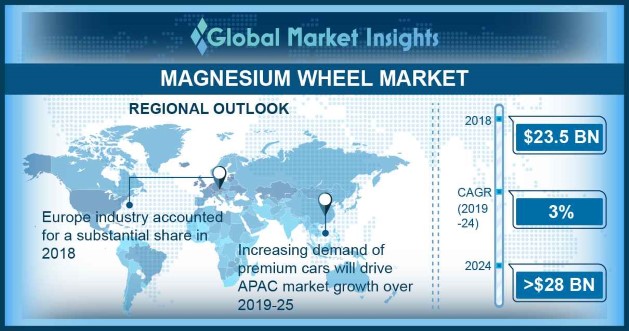Home > Automotive > Automotive Parts > Tires and Wheels > Magnesium Wheel Market
Magnesium Wheel Market Size
- Report ID: GMI2129
- Published Date: Apr 2019
- Report Format: PDF
Magnesium Wheel Market Size
Magnesium Wheel Market size valued at over USD 23.5 billion in 2018 and is estimated to exhibit around 3% CAGR from 2019 to 2024.
Rising preference of automobile OEMs to lower vehicle weight for improving fuel efficiency along with lowering carbon emissions are driving the magnesium wheel market size over the forecast timeframe. Increasing demand for lightweight automotive components offering superior mechanical properties will positively influence the product penetration. Customers are opting for specially designed wheels that offer significant performance advantage along with improving vehicle aesthetics significantly.
Magnesium wheels offer superior thermal conductivity that enables for easier heat dissipation compared to traditional wheels. Additionally, these wheels offer smoother ride and softer cushioning, thereby contributing significantly toward improving the driving conditions in uneven and bad roads. Growing demand for high quality automotive exterior components along with stiffer and durable wheel structure is positively influencing the magnesium wheel market demand over the study timeframe.
Increasing per capita disposable income is significantly escalating the adoption of premium cars. For instance, in 2018, luxury car sales in Russia rose to 1,463 units with an increase of over 1.6% as compared to 2017. Rising prominence of premium cars offering enhanced manoeuvrability and handling stability will significantly fuel the market share over the forecast period.
| Report Attribute | Details |
|---|---|
| Base Year: | 2018 |
| Magnesium Wheel Market Size in 2018: | 23.5 Billion (USD) |
| Forecast Period: | 2019 to 2024 |
| Forecast Period 2019 to 2024 CAGR: | 3% |
| 2024 Value Projection: | 28 Billion (USD) |
| Historical Data for: | 2013 to 2018 |
| No. of Pages: | 270 |
| Tables, Charts & Figures: | 436 |
| Segments covered: | Manufacturing, End-Use, Vehicle and Region |
| Growth Drivers: |
|
| Pitfalls & Challenges: |
|
Rising preference for personal green mobility solutions along with rising demand for premium & sports cars and bikes are boosting the magnesium wheel market over the projected timeframe. Stringent government regulations pertaining to lowering emissions and improving fuel efficiency are enabling manufacturers to invest in advanced technologies for producing such wheels. For instance, the Corporate Average Fuel Economy (CAFE) standards set by the National Highway Traffic Safety Administration (NHTSA) focuses on improving fuel efficiency of vehicles every year.
Industry players are currently incorporating magnesium wheels in their premium and luxury vehicles for improving their market share. The higher product prices compared to the traditional steel & alloy wheels limit their usage in low-cost vehicles. However, automobile OEMs are investing in R&D for introducing innovative production technologies for introducing low-cost wheels. For instance, researchers from Ford Motors and AUTO21 are developing customized Tailor-Welded-Blank (TWB) and Friction Stir Welding (FSW) technologies, that felicitates the production of lower cost magnesium wheels, thereby catering to a wider customer base.
Higher cost associated with the procurement and processing of magnesium may restrict the market share over the study timeframe. Fluctuation in raw material prices owing to changing trade policies and tariff duties may further hamper the industry growth. Manufacturers are constantly investing in R&D for developing advanced manufacturing processes further supporting the magnesium wheel market growth. For instance, the MagSonic technology is used to produce magnesium using around 80% lower energy and around 60% lower carbon emission compared to the traditional processes.

